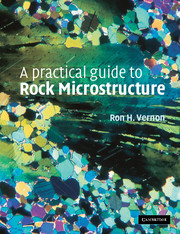Book contents
2 - Microstructures of sedimentary rocks
Summary
Introduction
Although this book is mainly concerned with igneous, metamorphic and deformation processes, in this chapter I briefly review the main sedimentary microstructures, partly because they need to be understood in order to interpret residual sedimentary microstructures in some metamorphic rocks.
The basic sedimentary microstructures are relatively straightforward, but variations (reflecting variable sedimentary environments) can be very complex, and many complicated classification schemes to deal with this complexity have been suggested. Classification schemes, microstructural details and discussions of sedimentary environments can be found in many excellent books (e.g. Pettijohn, 1949; Williams et al., 1954; Carozzi, 1960; Milner, 1962; Folk, 1968; Selley, 1970; Blatt et al. 1972; Bathurst, 1975; Friedman & Sanders, 1978; Adams et al., 1984, Greensmith, 1989; Boggs, 1992; McPhie et al., 1993; McLane, 1995).
Sediments are loose, unconsolidated fragments, and sedimentary rocks are the consolidated or lithified equivalents. Residual (pedogenic) sediments are essentially in situ deposits of the products of rock weathering, for example weathering crusts, soils and regoliths. Epiclastic (terrigenous) sediments are accumulations of solid fragments formed by erosion of existing rocks. Pyroclastic sediments are deposits of fragmented igneous material (e.g. volcanic glass and crystal fragments) ejected from volcanoes in explosive eruptions directly onto Earth's surface. Bioclastic sediments are accumulations of organic skeleton or shell fossils that have been at least slightly transported.
- Type
- Chapter
- Information
- A Practical Guide to Rock Microstructure , pp. 13 - 42Publisher: Cambridge University PressPrint publication year: 2004



